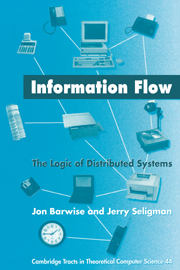Book contents
- Frontmatter
- Contents
- Preface
- Part I Introduction
- Part II Channel Theory
- 4 Classifications and Infomorphisms
- 5 Operations on Classifications
- 6 Distributed Systems
- 7 Boolean Operations and Classifications
- 8 State Spaces
- 9 Regular Theories
- 10 Operations on Theories
- 11 Boolean Operations and Theories
- 12 Local Logics
- 13 Reasoning at a Distance
- 14 Representing Local Logics
- 15 Distributed Logics
- 16 Logics and State Spaces
- Part III Explorations
- Answers to Selected Exercises
- Bibliography
- Glossary of Notation
- Index of Definitions
- Index of Names
11 - Boolean Operations and Theories
Published online by Cambridge University Press: 05 November 2011
- Frontmatter
- Contents
- Preface
- Part I Introduction
- Part II Channel Theory
- 4 Classifications and Infomorphisms
- 5 Operations on Classifications
- 6 Distributed Systems
- 7 Boolean Operations and Classifications
- 8 State Spaces
- 9 Regular Theories
- 10 Operations on Theories
- 11 Boolean Operations and Theories
- 12 Local Logics
- 13 Reasoning at a Distance
- 14 Representing Local Logics
- 15 Distributed Logics
- 16 Logics and State Spaces
- Part III Explorations
- Answers to Selected Exercises
- Bibliography
- Glossary of Notation
- Index of Definitions
- Index of Names
Summary
In Lecture 7 we discussed the relationship between classifications and the Boolean operations. In this lecture, we study the corresponding relationship for theories. In particular, we discuss Boolean operations that take theories to theories, as well as what it would mean for operations to be Boolean operations in the context of a particular theory. In this way, we begin to see how the traditional rules of inference emerge from an informational perspective. The topic is a natural one but it is not central to the main development so this lecture could be skipped.
Boolean Operations on Theories
Given a regular theory T = (Σ, ⊢), one may define a consequence relation on the set pow(Σ) of subsets of Σ in one of two natural ways, depending on whether one thinks of the sets of types disjunctively or conjunctively. This produces two new theories, ∨T and ∧T, respectively.
These operations should fit with the corresponding power operations ∨A and ∧A on classifications A; we want vTh(A) to be the same as the theory Th(∨A), for example. Thus, to motivate our definitions, we begin by investigating the relationship of the theory Th(A) of a classification to the theories Th(∨A) and Th(∧A) of its two power classifications.
Definition 11.1. Given a set Γ of subsets of Σ, a set Y is a choice set on Γ if X ∩ Y ≠ Ø for each X ∈ Γ.
- Type
- Chapter
- Information
- Information FlowThe Logic of Distributed Systems, pp. 138 - 148Publisher: Cambridge University PressPrint publication year: 1997



